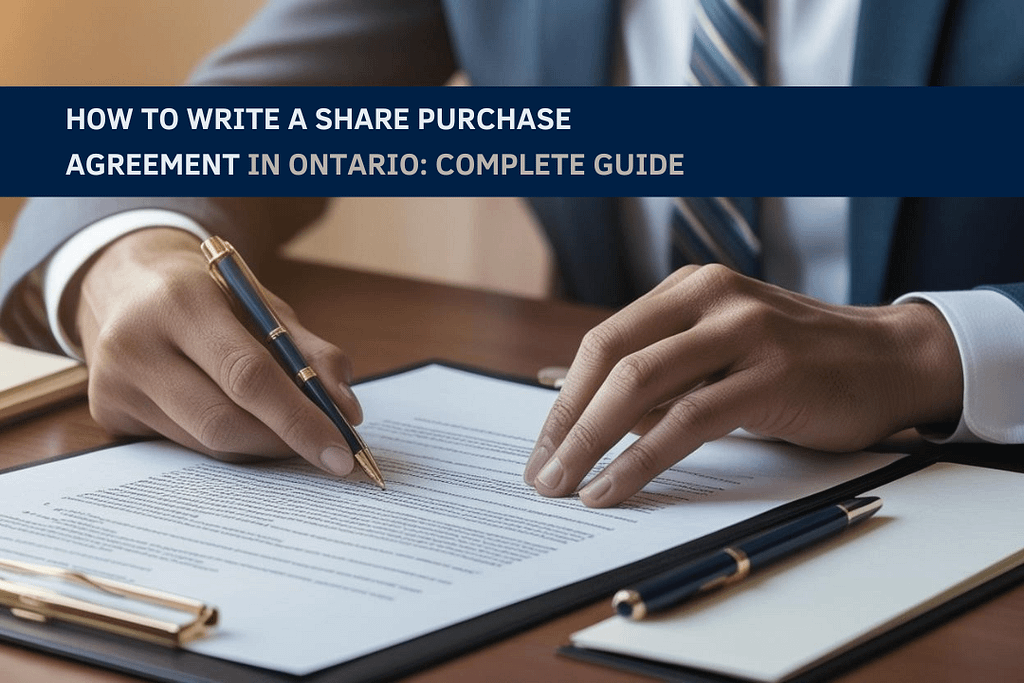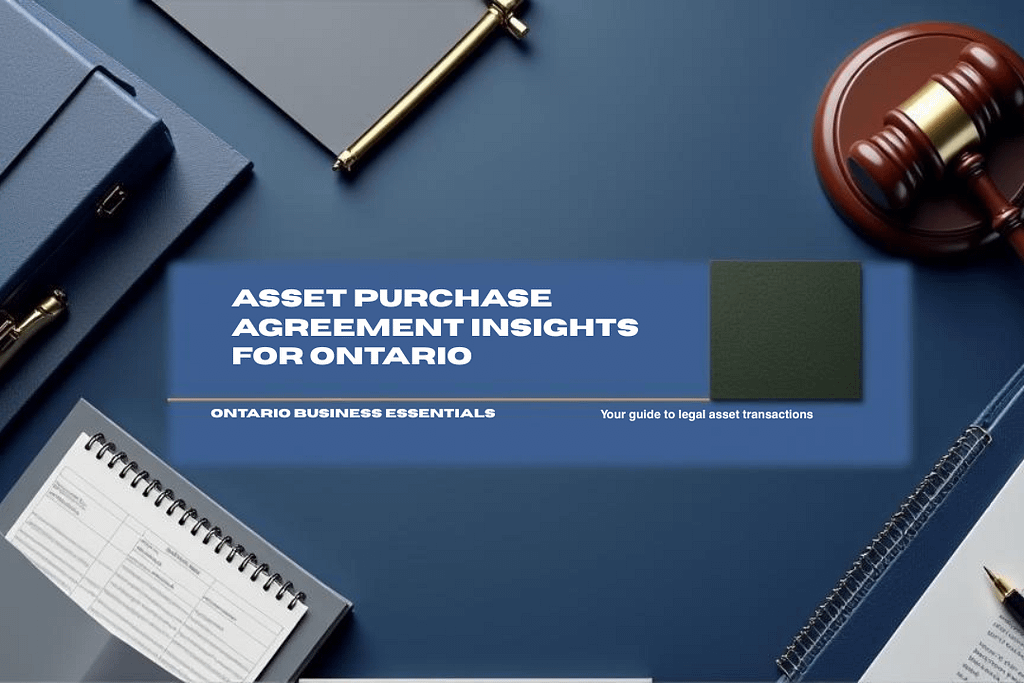In Ontario, the Agreement of Purchase and Sale (APS) is the legally binding contract that sets out the terms under which a seller agrees to transfer, and a buyer agrees to acquire an interest in property. Once signed, the APS governs the entire process from the initial deposit through to closing, allocating risks, obligations, and remedies between the parties.
Unlike a letter of intent, an APS has enforceable legal consequences under Ontario law. For commercial transactions, it must address conditions precedent such as financing and zoning approvals, environmental due diligence, representations and warranties, remedies in the event of default, and closing adjustments. Each clause operates to allocate risk and protect the parties in a complex and high-value environment.
This is the key document that sets out the terms of your deal and makes it legally enforceable. In simple terms, it’s the formal sales agreement where one party agrees to purchase and the other agrees to sell u3nder specified conditions. Understanding the essential elements of this contract is crucial especially in Ontario’s legal context to ensure your agreement is legally binding and protects your interests. In this guide, we’ll explain in plain language what a Contract of Purchase and Sale is, its role, whether it’s legally binding in Ontario, why each element matters, common mistakes to avoid, and how a lawyer can help you navigate the process.
What Is A Contract Of Purchase And Sale?
A Contract of Purchase and Sale is a formal legally binding contract between a buyer and a seller outlining the terms and conditions of a transaction. It sets out the buyer’s intention to buy a specific property (or asset) for a specified price and the seller’s agreement to sell on those terms, usually with certain conditions attached. Once both parties sign the contract, it becomes a legally enforceable agreement, meaning neither party can back out without potential legal consequences.
In an Agreement of Purchase and Sale, all important terms of the deal are documented in writing. These typically include details like the purchase price, a description of the property or item being sold, the closing, and any conditions or contingencies that must be met for the sale to go through. In a business purchase agreement, the contract would list details about the business assets or shares being transferred, the purchase price and payment structure, and any conditions like due diligence or regulatory approvals.
Also Read: Legal Services for Buying or Selling a Convenience Store in Canada
Role Of The Purchase And Sale Contract
The purchase and sale contract plays a critical role in any significant transaction. It serves as the roadmap of the deal, outlining each party’s rights and obligations and providing a clear path to closing. Here’s why this contract is so important:
1. Clarity and Detail: A written Contract of Purchase and Sale lays out all the terms that the buyer and seller have agreed upon such as what exactly is being sold, for how much, when the exchange will happen, and who must do what before completion. By documenting these terms, the contract minimizes misunderstandings. Both parties can refer to the agreement to resolve any confusion.
2. Legal Protection: This contract is legally enforceable, which means it provides recourse if the other party doesn’t honour the deal. If a buyer or seller tries to back out or fails to meet their obligations, the injured party can rely on the contract to seek a remedy.
3. Framework for the Transaction: The contract sets out the timeline and process of the sale. It typically includes dates and deadlines; for example, when a deposit must be paid, when conditions must be satisfied or waived, and the closing date when the title or ownership transfers. This keeps the transaction on track.
4. Compliance with Law: The purchase and sale contract ensure compliance with legal requirements. By having a proper written contract, you satisfy these legal formalities and avoid the deal being invalid for technical reasons.
Also Read: How to Write a Share Purchase Agreement in Ontario: A Complete Guide.
Is An Agreement Of Purchase And Sale Legally Binding In Ontario?
Yes. In Ontario, once an Agreement of Purchase and Sale (APS) is signed by both the buyer and seller, it becomes a legally binding contract on those parties. This means each party is obligated to carry out the deal according to the terms of the agreement. For example, if a buyer refuses to complete the purchase without a valid reason permitted by the contract, the seller may be entitled to keep the buyer’s deposit or sue for additional damages. Likewise, if a seller tries to back out, the buyer could potentially seek an order for the sale to go through or claim losses.
However, being “legally binding” doesn’t mean every APS is absolute and unconditional from the moment of signing. Many Agreements of Purchase and Sale include conditions (contingencies); for example, “subject to financing approval” or “conditional on a home inspection.” These clauses mean the contract is conditionally binding. While the condition is pending, both parties are generally bound to proceed in good faith to try to fulfil it, but the contract might allow one or both parties to walk away without penalty if the condition isn’t met by a certain date.
Schiller et al. v. Fisher et al. [1981] 1 SCR 593
In this case, Kingsmont Properties sought to purchase twenty-three building lots from Nu-Towne Developments and had paid a $20,000 deposit. Nu-Towne sent a revised agreement on August 20, 1976, with a deadline of August 27 for acceptance. Kingsmont returned the agreement on that date with minor changes, effectively making a counter-offer, and requested that Nu-Towne initial the changes and return a copy promptly. Nu-Towne initialled the agreement on September 1 and returned it by post, but Kingsmont claimed the acceptance was late and demanded the deposit.
The main issue was whether an enforceable contract for the sale and purchase of the land had been formed. The Supreme Court held that a valid contract had been created. Kingsmont’s letter indicated an intention that acceptance would be effective once Nu-Towne initialled and returned the agreement. Nu-Towne’s actions satisfied the prescribed method and timing for acceptance. Consequently, the trial court’s original finding that a binding contract existed was restored, and the Court of Appeal’s decision overturning it was set aside. The case highlights that a counter-offer followed by acceptance communicated in the intended manner can create a valid and enforceable contract of purchase and sale.
Also Read: Why Every Buyer and Seller Needs a Solid Sale and Purchase Agreement
Key Clauses In A Contract Of Purchase And Sale
For a Contract of Purchase and Sale to be enforceable (legally valid and binding) in Ontario, it must contain several essential elements of a contract. These elements are the pillars that uphold any contract under Ontario law. If any of these elements is missing or flawed, the contract could be void or voidable. Below explained are each essential element.
1. Parties to the Agreement
This clause is essential to every valid contract. Every contract begins by clearly identifying who is entering into the agreement. This section specifies the legal names of both the buyer and the seller, along with their legal status (for example, an incorporated company or an individual). Getting this right is crucial because it determines who will be bound by the agreement. If the parties are not correctly named, enforcing the agreement could become complicated or even impossible.
2. Description of Assets or Shares
The heart of the agreement lies in what is being sold. In a business acquisition, this could mean the transfer of assets such as inventory, equipment, and intellectual property, or it could mean the sale of shares in a corporation. The contract must spell out exactly what is included and excluded. Without clear wording, the buyer might assume certain assets are part of the deal while the seller believes otherwise.
3. Purchase Price and Payment Terms
This clause establishes not only the price but also when and how it is to be paid. It can be in the form of a lump sum, instalments, or even in combination with part cash and assumption of debt. Payment terms sometimes incorporate information regarding deposits, payment schedule, and penalties for late payment. A properly negotiated clause provides certainty for both parties and removes ambiguity regarding the time of transfer of funds.
Example: A buyer may offer to pay part of the amount upfront and the balance in instalments over a few years. This can be put on a secured note to safeguard the seller in case of default by the buyer.
4. Conditions Precedent
Conditions precedents are the “if-then” conditions of the agreement. They bind the contract only if specified events take place. Typical conditions include financing, successful due diligence, landlord approval to assign a lease, or regulatory approvals. The clauses protect both parties by not letting the transaction close before the essential requirements are fulfilled.
Example: A purchaser will only buy the business if their lender will approve financing. In the event of a failure to finance, the purchaser is not put in an impossible position.
5. Representations and Warranties
These are assurances made by the seller, and sometimes the buyer, about the state of the business. They provide a snapshot of the business at the time of sale and allocate responsibility if something is not as promised. For the buyer, these assurances reduce the risk of hidden problems. For the seller, they clarify the limits of what they are guaranteeing.
6. Indemnity Clause
An indemnity shifts responsibility for losses to one party if specific problems arise. In business acquisitions, the seller usually agrees to cover the buyer for liabilities that existed before closing but were not disclosed. This protects the buyer from inheriting costly surprises.
7. Non-Compete Clause
This clause prevents the seller from setting up a new business that competes with the buyer right after the sale. Without this restriction, a seller could use their knowledge, relationships, and reputation to undermine the buyer’s investment. Non-compete clauses usually limit both time and geography to remain enforceable.
8. Confidentiality Clause
Negotiations and due diligence often involve the exchange of sensitive information, such as client lists, pricing structures, or trade secrets. A confidentiality clause ensures that this information remains private, whether or not the sale goes through. This protects the business from potential misuse of information.
9. Taxation clause
This clause ensures that both the buyer and the seller clearly understand their tax obligations arising from the transaction. It typically provides that the seller is responsible for all taxes relating to the operation of the business before the closing date, while the buyer assumes liability for taxes after closing. It also addresses sales taxes such as Ontario’s Harmonized Sales Tax (HST), specifying whether it applies and who will collect and remit it, or whether an exemption applies. This clause is critical because it allocates risk fairly and ensures neither party is caught off guard by tax arrears or obligations tied to the wrong period of ownership.
10. Closing Arrangements
The closing clause sets out the mechanics of finalizing the transaction. It details the exchange of documents, the delivery of payment, and the transfer of ownership. A structured closing avoids chaos on the final day and ensures both sides fulfill their obligations in sync.
11. Governing Law and Jurisdiction
Since laws vary from place to place, the agreement must state which legal system applies. For transactions in Ontario, this clause makes it clear that Ontario law governs the contract and that disputes will be resolved in Ontario courts. This ensures predictability and reduces the risk of forum shopping. If a dispute arises, both parties know they must resolve it in Ontario under Ontario law, even if the buyer resides elsewhere.
12. Entire Agreement Clause
Over the course of negotiations, parties may make many promises or side comments. The entire agreement clause ensures that only what is written in the contract is enforceable. This provides clarity and avoids misunderstandings based on verbal discussions.
Important Case Laws
Bellisario v. 2200 Bromsgrove Development Inc. (2025 ONSC 2546)
The case concerned whether a developer could charge buyers of townhouses for large “utility and infrastructure” costs at closing, even though these charges were not expressly provided for in the Agreement of Purchase and Sale (APS).
The Court ruled that the APS only permitted adjustments for specific items such as utility connection fees billed directly by municipalities or service providers, and not broad contractor or infrastructure costs that the developer attempted to pass along. In reaching this conclusion, the Court stressed that any ambiguity in the drafting of adjustment clauses would be interpreted against the developer under the doctrine of contra proferentem. It also held that a certificate issued by the developer was not binding where it was misleading, and that limitation of liability provisions could not shield the developer from improperly levied charges. The case underscores the importance of precision and transparency in drafting adjustment clauses, making clear that developers in Ontario cannot rely on vague wording to impose costs beyond what is expressly authorized in the APS.
Brighton Breeze Ltd. v. Noel Property Management Ltd. (2025 ONSC 2377)
The Plaintiff, Brighton Breeze Ltd. (“Brighton”), entered into an Agreement of Purchase and Sale (APS) with the Defendant, Noel Property Management Ltd. (“Noel”), for the purchase of a waterfront property in Brighton, Ontario, for $950,000. The APS included an annulment clause allowing the agreement to end if valid title objections were not resolved. A notice under s. 71 of the Land Titles Act was registered on the property by a neighbouring condominium corporation (NSCC48), which led to the transaction not closing. Brighton alleged Noel breached the APS by failing to transfer clear title, while Noel maintained it was ready to close if Brighton waived its objection.
The court granted the seller’s motion: it held that a vendor is not required to litigate or force removal of a third-party notice beyond its control. The decision underscores that in Ontario an APS must clearly define obligations about title defects. A buyer cannot always compel a seller to remove third-party claims or notices, especially where those claims derive from independent third parties and not from the seller’s own actions. Drafting an annulment or objection clause carefully, and deciding whether to accept title with a known notice, are critical in commercial APSs.
Reel em Inn and Resort v. RNR Doemel Enterprises et al, 2025 ONSC 805
The Plaintiff, a resort operator, entered into an Agreement of Purchase and Sale with the Defendants, who owned a seasonal general store property. The Plaintiff paid a $50,000 deposit for the $389,900 purchase. Before closing, the Plaintiff discovered outstanding work orders related to a fuel tank on the property, which the Defendants had not disclosed. The Plaintiff sought rescission of the contract and a return of the deposit, while the Defendants counterclaimed for forfeiture of the deposit and damages.
The court held that the defendants repudiated the contract, and the plaintiff accepted this repudiation, effectively terminating the Agreement. The defendants were found liable to return the $50,000 deposit. The case underscores the importance of compliance with contractual conditions, due diligence on latent defects, and the consequences of refusing amendments to address critical issues prior to closing.
Common Mistakes To Avoid
When creating or signing a Contract of Purchase and Sale, people can inadvertently make mistakes that undermine the effectiveness of the agreement or lead to disputes. Here are some common mistakes to avoid; knowing these can save you from legal headaches down the road:
1. Not putting the agreement in writing: As discussed, a verbal understanding isn’t enough, and it’s risky for any substantial transaction. It is hence recommended that the agreement must be in writing- a properly drafted Agreement of Purchase and Sale or sales contract that both party’s sign.
2. Making last-minute changes or side notes that are not agreed by all: This mistake often happens in fast-moving deals, perhaps one party wants to change a term and scribbles a change in the contract or adds a document (like a schedule) after the other party has signed, without formal acceptance. One should never assume a change is agreed upon until the other party signs or initials it. Also, one should not rely on verbal acknowledgments for changes. Always document amendments in writing. And once the contract is signed, you generally cannot unilaterally add terms. Any modification must be by mutual agreement (often done via a written amendment or schedule signed by both).
3. Leaving out essential details or using vague language: An incomplete or unclear contract is a dispute waiting to happen. Mistakes here include not specifying exactly what is included in the sale, not clearly defining conditions, or using imprecise terms. Clarity is of utmost importance.
4. Missing signatures or parties: A surprisingly common oversight is not getting all necessary signatures. For example, if a property is jointly owned by a couple, both should sign the APS as sellers. If only one signs, the contract may not be enforceable against the non-signing owner. Signs of all parties are required for a valid contract.
How A Lawyer Can Help
Navigating the legalities of a Contract of Purchase and Sale can be overwhelming for a layman. In Ontario, while many transactions start with standard forms, the stakes are high and the fine print matters. A lawyer’s guidance is invaluable in ensuring your contract is sound, enforceable, and aligned with your interests. Here are several ways a lawyer can help in the context of a purchase and sale agreement:
1. Drafting or Reviewing the Contract: A lawyer can draft a custom contract for your sale or thoroughly review a contract before you sign it. This is crucial for catching any unfavourable terms or omissions. The lawyer will explain in plain language what each clause means for you. If something is not in your best interest, they can suggest revisions. This step can prevent you from agreeing to something you don’t intend or from missing an important protection.
2. Ensuring All Essential Elements and Legal Requirements Are Met: As we discussed, the contract must have all the essential elements (offer, acceptance, consideration, etc.) and meet formal requirements (like writing and signing for real estate). A lawyer will check that the contract indeed has clearly identified parties, proper property description, price, etc., that all parties have signed correctly, and that it adheres to Ontario laws.
3. Negotiating Terms and Protecting Your Interests: Lawyers can also negotiate on your behalf or guide you on negotiating the terms. They understand what’s customary in Ontario for similar deals and where there’s room to secure a better term for you. Say you’re the buyer and the seller wants a very short closing date- your lawyer might negotiate a longer period so you have time to arrange financing. If you’re the seller, your lawyer might suggest a larger deposit or certain representations from the buyer if something seems risky. Lawyers also help in allocating risks properly.
4. Explaining and Clarifying Complex Terms: Contracts can be full of legal jargon or shorthand terms that a layman might not understand (like “time is of the essence,” “encumbrances,” “force majeure,” etc.). A lawyer will explain what each of these means in practical terms.
5. Problem-Solving and Dispute Resolution: If any issues arise during the process, a lawyer can step in to solve them. Lawyers can negotiate an amendment or extension with the other side’s lawyer in a structured way. They can also advise if the issue is serious enough to terminate the contract under a clause or law.
Also Read: Why Choose Lawyers for Purchase and Sale Agreement in Ontario
Conclusion
Entering a contract of purchase and sale is exciting but it’s also a serious legal step. By understanding its essential elements- offer and acceptance, consideration, intention, capacity, legality, clear terms, and proper form- you can appreciate why each clause in that agreement is there and what it means. In Ontario, paying attention to things like the requirement for written agreements (and the rare exceptions) can make the difference between a secure deal and a shaky one. Avoid common pitfalls by being diligent with your contract and don’t hesitate to get professional help. With the right precautions, your Agreement of Purchase and Sale will do exactly what it’s meant to: secure a fair and binding deal that gets you safely from agreement to closing.
Don’t leave your purchase or sale to chance. Our lawyers can help you draft, review, or negotiate your Agreement of Purchase and Sale so your interests are fully protected. Speak to a Lawyer Today








